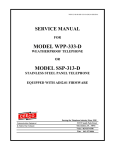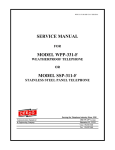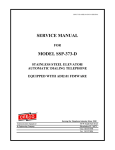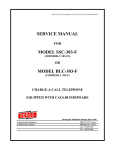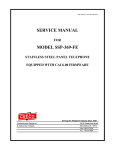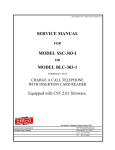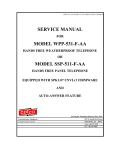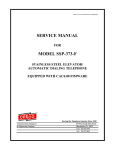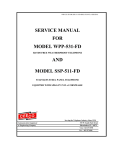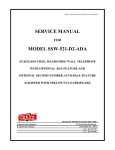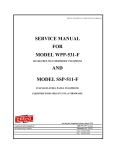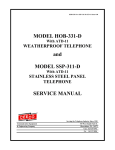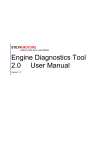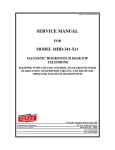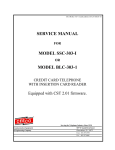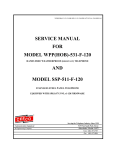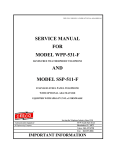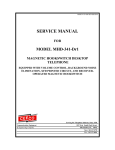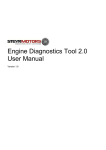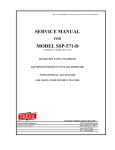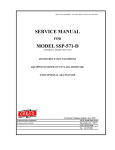Download SERVICE MANUAL MODEL SSP-363-E4
Transcript
SSP-363-E4-(SSP-365-E-4)-AUTODIAL48-ISSUE4.0 SERVICE MANUAL FOR MODEL SSP-363-E4 (FORMERLY SSP-365-E-4) STAINLESS STEEL PANEL TELEPHONE EQUIPPED WITH AUTODIAL48 FIRMWARE Serving the Telephone Industry Since 1930 Communication Equipment & Engineering Company 519 W South Park Street Okeechobee, FL 34972 Voice: 863-357-0798 Fax: 863-357-0006 ISSUE 4.0 IMPORTANT INFORMATION FOR CUSTOMER Please fill in before you continue. The following information is necessary when calling CEECO for assistance. MODEL NUMBER MODEL SSP-363-E4 EQUIPPED WITH AUTODIAL48 FIRMWARE SERIAL NUMBER DATE MANUFACTURED LOCATION INSTALLED For us to better serve you, please have this information available when calling for technical support. CEECO Communication Equipment & Engineering Company 519 W South Park Street Okeechobee, FL 34972 863-357-0798- telephone 863-357-0006- facsimile [email protected] www.ceeco.net CEECO Communication Equipment & Engineering Company PROPRIETARY 2 ISSUE 4.0 TABLE OF CONTENTS SECTION PAGE 1.0 INTRODUCTION................................................................................................... 4 2.0 GENERAL............................................................................................................... 4 3.0 PROGRAMMING .................................................................................................. 5 PROGRAMMING CONTINUED…..................................................................... 6 4.0 TESTING................................................................................................................. 6 5.0 RECOMMENDED TOOLS AND TEST EQUIPMENT .................................... 8 6.0 INSTALLATION INSTRUCTIONS .................................................................... 8 7.0 SPECIFICATIONS................................................................................................. 9 8.0 PARTS LIST ......................................................................................................... 10 9.0 FCC NOTICE........................................................................................................ 11 10.0 REPAIR & RETURN POLICY .......................................................................... 12 11.0 WARRANTY POLICY ........................................................................................ 13 12.0 MINI-JUMPER DIAGRAM................................................................................ 14 CEECO Communication Equipment & Engineering Company PROPRIETARY 3 ISSUE 4.0 1.0 INTRODUCTION The practices in this manual provide installation, programming and maintenance information for CEECO Model SSP-363-E4 Stainless Steel Panel Telephone, equipped with version AUTODIAL48 firmware. The information in this manual is subject to change without notification. For information not included in this manual, please call or write: CEECO Customer Service 519 W South Park Street Okeechobee, FL 34972 863-357-0798- telephone 863-357-0006- facsimile [email protected] www.ceeco.net 2.0 GENERAL 2.1 The CEECO Model SSP-363-E4 Stainless Steel Panel Telephone is a microprocessor-based telephone designed to deter fraud from hand-held tone dialers and hookswitch dialing. The microprocessor keeps the transmitter muted (off) during periods of dial tone to guard against the use of hand-held dialers. Attempts to dial a number by tapping the hookswitch will cause the microprocessor to "reset" and open the line, thereby avoiding fraudulent call attempts. 2.2 One of forty-eight (48) pre-programmed numbers may be speed dialed, by pressing one key on the Single Button Access (SBA) panel, located on the front of the telephone. The panel consists of four keypads grouped together to form the forty-eight (48) speed dial keys. Each of the keys may be used to speed dial one number of up to twelve (12) digits in length. 2.3 Programming is accomplished via the top left, 12-button, SBA keypad. The top left keypad is used to program the speed dial numbers for all forty-eight (48) keys. 2.4 The phone may be programmed to allow or block incoming calls. CEECO Communication Equipment & Engineering Company PROPRIETARY 4 ISSUE 4.0 3.0 PROGRAMMING THIS EQUIPMENT IS TELEPHONE LINE POWERED. DURING PROGRAMMING THE CENTRAL OFFICE OR PBX MAY RESPOND TO THE PROGRAMMING CODES WITH VARIOUS BUSY TONE, REORDER TONE, RECORDINGS, ETC. THESE TONES AND RECORDINGS WILL HAVE NO EFFECT ON THE PROGRAMMING. PLEASE IGNORE THEM. 3.1 Utilizing the security tool (P/N 301-037 sold separately) remove the telephone from its housing/mounting. Connect the Telephone line cord to a working telephone line or a DTMF test set. 3.2 Looking at the rear of the telephone, locate the two plastic mini-jumpers on the Printed Circuit Board. Move them to the “ON” position as depicted in the diagram on the last page of this manual. 3.3 Now, looking at the front of the phone, observe four keypads (2 x 6 keys each) grouped together. The top left keypad is used for all programming. Please refer to the keypad configuration diagram on page 7. The corresponding digits for the top left programming keypad are illustrated on the keys themselves. The corresponding programming locations for all forty-eight (48) keys are indicated to the right of each key. It is important to be slow and deliberate when pressing the keys during programming. A missed or partial tone could result in improper programming. 3.4 Lift the handset and wait for dial tone to begin programming. Utilizing the top left keypad, enter # 9 7. This will clear all programmable memory locations to begin the programming sequence. 3.5 Enter # 0 0, followed by 0 1 1(to allow incoming calls) or 0 0 1(to block incoming calls. For example: Entering #00011 will program the phone to permit incoming calls, and conversely entering #00001 will program the phone to block incoming calls. One of these choices must be programmed into the phone in order for the phone to operate properly. 3.6 Each of the forty-eight (48) keys on the front of the telephone has its own speed dial programming location (#01 thru #48). Each location will store a number of up to twelve (12) digits in length. The diagram on page 7 depicts the correlation between the keys and the programming locations. The corresponding programming locations appear to the right of the keys. Utilizing the top left programming keypad, enter the programming location of the desired key, followed by the desired speed dial number for that particular key. For example: Enter #015551212. When in operation, this will cause the phone to automatically dial the number 5551212, when the very top left key is pressed. All forty-eight (48) keys may be programmed in this manner (i.e.#015551212#025875430#03911 #045875440#055617878#064219090…). CEECO Communication Equipment & Engineering Company PROPRIETARY 5 ISSUE 4.0 PROGRAMMING CONTINUED… It is recommended that only six (6) keys receive programming at one time. Those six keys should then be tested to ensure proper programming, before continuing on. To test them, hang up the phone and return the two plastic mini jumpers to the “OFF” position, as depicted on the last page of this manual. Then lift the handset, wait for dial tone, and press one of the programmed keys. The programmed number should automatically dial out. If not, try programming the failed key(s) again. Do this for each of the keys. Once programming of those keys is successful, proceed with the next group of keys. Remember to move the mini-jumpers to the “ON” position to program and the “OFF” position to test. Overall, this is the best approach toward achieving proper programming without unnecessary wasted time. 3.7 4.0 When programming has been completed, hang up the phone. Return the two plastic mini-jumpers to the “OFF” position, as depicted on the last page of this diagram. TESTING 4.1 Lift the handset and wait for dial tone. This may take a second or two. The handset transmitter will be muted. 4.2 Press one of the forty-eight (48) keys, which has been preprogrammed with a speed dial number. The programmed number will speed dialed out. The handset transmitter will then be enabled. Normal phone operation should follow. 4.3 Keep the telephone off hook and allow the called party to hang up first. Wait for the Central Office Equipment or PBX to time out and return dial tone. 4.4 As soon as dial tone is received, three (3) tones will be heard. The phone will momentarily open the line. The phone will then reset for another call. The handset transmitter will be disabled. 4.5 Place a call into the telephone. If incoming calls are not allowed, the handset transmitter will not turn on. If incoming calls are allowed, the transmitter will turn on approximately three (3) seconds after the incoming call is answered. 4.8 Attempt to "Hookswitch Dial" by tapping quickly on the hookswitch. The telephone should hang up, re-seize the telephone line and return dial tone. CEECO Communication Equipment & Engineering Company PROPRIETARY 6 ISSUE 4.0 KEYPAD LAYOUT DIAGRAM… PROGRAMMING KEYPAD TOP LEFT PROGRAMMING LOCATIONS APPEAR TO RIGHT OF KEYS #01 #13 #25 #37 #02 #14 #26 #38 #03 #15 #27 #39 #04 #16 #28 #40 #05 #17 #29 #41 #06 #18 #30 #42 #07 #19 #31 #43 #08 #20 #32 #44 #09 #21 #33 #45 #10 #22 #34 #46 #11 #23 #35 #47 #12 #24 #36 #48 CEECO Communication Equipment & Engineering Company PROPRIETARY 7 ISSUE 4.0 5.0 RECOMMENDED TOOLS AND TEST EQUIPMENT Volt Meter 1/4" Nut Driver Flat Blade Screw Driver Security Tool P/N 301-037 6.0 INSTALLATION INSTRUCTIONS 6.1 Using a 301-037 security tool (sold separately), loosen and remove the security screws. 6.2 The security tool is for a standard 5/32" button head screw generally used on the framework of the phone booths. 6.3 The station ground should not exceed 50 ohms. 6.4 Run the inside station wire and terminate onto the RJ11C terminal block. 6.5 Plug the modular line cord from the telephone assembly into the RJ11C terminal block. 6.6 Dress the line cable away from the security screws and install the cover assembly. 6.7 Secure the cover assembly by tightening the security screws. *****WARNING***** A. Never install telephone wiring during a lightening storm. B. Never install telephone jacks in wet locations unless the jack is specifically designed for wet locations. C. Never touch uninsulated telephone wires or terminals unless the telephone line has been disconnected at the network interface. D. Use caution when installing or modifying telephone lines. CEECO Communication Equipment & Engineering Company PROPRIETARY 8 ISSUE 4.0 7.0 SPECIFICATIONS INPUT POWER: C.O. Line Powered LOOP CURRENT: 23ma Min 80ma Max IMPEDANCE: 600 Ohms SIGNALING: DTMF-70ms Tone, 50ms Spacing OUTPUT LEVEL: -10.0 to -12.0 dBm SIGNALING: Pulses 10 PPS or 20 PPS 50% Break HEARING AID COMPATIBLE: Meets EIA Standards ENVIRONMENTAL: Temperature- 50°C, Humidity 20% - 90% non-condensating PROGRAMMING: Via External DTMF Keypad TELEPHONE PANEL: Stainless Steel (14ga) SIZE: 14 1/4" Wide x 12 1/2" High x 2 3/4" Deep (Handset on hook) MEMORY RETENTION: Lithium Battery - (long life) FCC REGISTRATION: BW88T7-13823-TE-T UL LISTED NO.: 6OF5 RINGER EQUIVALENCE: 0.4A TYPE JACK: RJ11C PROGRAM: AUTODIAL48 CEECO Communication Equipment & Engineering Company PROPRIETARY 9 ISSUE 4.0 8.0 PARTS LIST QUANTITY PART NUMBER DESCRIPTION 1 301-018 Modular Cord 1 365-E-4 Telephone Panel 1 301-004 Handset 1 301-588 Hookswitch Cradle 1 301-581 Tongue and Bracket 2 301-570 Microswitch 4 306-105 SBA Panel 4 700-008 SBA Cable 1 301-009 Network 1 650-520 MCRK - 2 PC Board (Modified) 1 301-054 Modular Jack 6 301-012 Security Screws 4 12029 Single Button Access (SBA) Keypad ACCESSORIES: 1 700-008 Keypad Cable 1 301-037 Security Tool 1 401-009 Ringer CEECO Communication Equipment & Engineering Company PROPRIETARY 10 ISSUE 4.0 9.0 FCC NOTICE 9.1 FCC REGISTRATION AND REPAIR INFORMATION Your new telephone has been registered with the Federal Communication Commission (FCC) in accordance with Part 68. The FCC requires that you be advised of certain requirements involving the use of this telephone. 9.2 CONNECTION WITH THE NATIONWIDE TELEPHONE NETWORK The FCC requires that you connect this telephone to the Nationwide Telephone Network through a registered jack provided by the Telephone Company in your area. This jack is a modular outlet, which you can order from your local telephone company. 9.3 NOTIFICATION TO THE TELEPHONE COMPANY Before connecting this telephone, the FCC requires that you notify your local telephone company business office. The number is in the front of your phone book. Tell them: The "line" to which you will connect the telephone (that is, your phone number) and the telephone's FCC registration number and ringer equivalence number. These numbers are listed in section 9.00. The FCC further requires that you notify your local telephone company when permanently disconnecting this telephone. CEECO Communication Equipment & Engineering Company PROPRIETARY 11 ISSUE 4.0 10.0 REPAIR & RETURN POLICY 10.1 WARRANTY REPAIR Any device returned requiring warranty service, repair or credit must be accompanied with a "Return Material Authorization (RMA) Number” and must also include: return shipping instructions, original purchase order number and special marking instructions. A description of the trouble observed must be attached to the defective unit. This information must be inside the shipping container. 10.2 DIRECT ALL INQUIRES TO: CEECO Repair Department 863-357-0798- telephone 863-357-0006- facsimile [email protected] www.ceeco.net 10.3 NON-WARRANTY REPAIR CEECO will repair equipment out of warranty for a set charge plus parts. The customer must pay the shipping costs both directions. 10.4 RETURN FOR CREDIT Material may be returned for credit only with prior approval. Material authorized for return is subject to a 20% restocking charge based on the manufacturer’s list price. Return Material Authorization must be requested no later than 30 days after original shipment. CEECO Communication Equipment & Engineering Company PROPRIETARY 12 ISSUE 4.0 11.0 WARRANTY POLICY 11.1 GENERAL CEECO products are guaranteed to be free of defects in material and workmanship for a period of 365 days from the date of original shipment. CEECO’s obligation under this warranty is limited to repair or replacement of any part found to be defective by CEECO. Under no circumstances shall CEECO be liable for loss, damage, cost of repair or consequential damages of any kind, which have been caused by neglect, abuse, acts of God or improper operation of equipment. CEECO will repair or replace any unit during this period if found to be defective for reasons other than abuse and improper use or improper installation. It is the buyer’s responsibility to return the defective unit to the factory. CEECO will then repair or replace any defective parts and return them to the buyer free of charge. 11.2 PRINTED CIRCUIT BOARDS Printed circuit boards should not be repaired in the field. If a unit is found to be faulty, replace it with another unit and return the faulty unit to CEECO for repair. Modifications by anyone other than CEECO will void the warranty. CEECO Communication Equipment & Engineering Company PROPRIETARY 13 ISSUE 4.0 12.0 MINI-JUMPER DIAGRAM Locate the mini jumpers on the corner of the PCB. ON F OF MOVE THE MINI JUMPERS TO THE ON POSITION BEFORE GOING OFF-HOOK. ON F OF When programming is completed, move the mini- jumpers to the OFF position. ON F OF NOTE: Do not leave the mini-jumpers in the ON position; this will decrease battery life. CEECO Communication Equipment & Engineering Company PROPRIETARY 14














